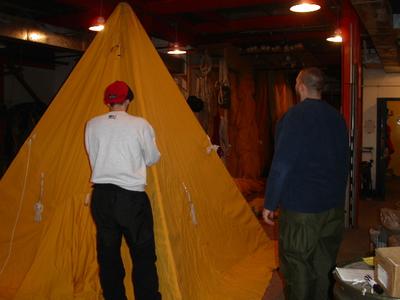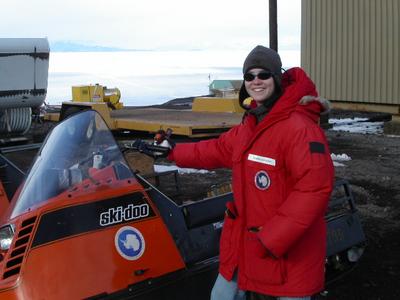28 December, 2002
Preparations For Departure Into The Field
Today was a very busy day. We met for breakfast at 7:00. After that we headed straight to the Berg Field Center (BFC) to begin an inventory of all the equipment we would need on our trip. It was something I had thought very little about in my preparation for this trip because it is the responsibility of the Principal Investigator to plan out the trip. However, it is the responsibility of the entire team, once we arrive, to work together to get ready to enter the field. This requires that we do a great deal of planning, teamwork, and cooperation not only among ourselves, but with many of the various departments here at McMurdo Station.
Our equipment is stored in a caged room in the BFC. It is here that much of the equipment and supplies ordered by Brenda Hall, the principal investigator (PI), have been delivered and stored in a locked room. We began by pulling very large duffle bags out of the cage and into the work area. These dusty navy or green duffle bags contained down sleeping bags, a fleece liner for the bags, a urination bottle, and a foam pad. We each received a duffle and checked our sleeping bag and liner to make sure the zippers worked properly. Then we checked our foam pads and then rolled them and tied them with rope to keep them compressed in the duffle bag, we also labeled our bottles.
When packing items, volume (the amount of space an object occupies) is very important and we try to keep things very compact to conserve space. Weight is also important. Every item must be weighed and then tagged with a label indicating the weight and our research group number, which is I-196. Weight is important because our supplies will be bundled as a sling load and then lifted by the helicopters (helo) to be delivered to our field camp. The helo pilots must know exactly how much the load is in order to ensure a safe flight.
Next we unwrapped four Scott tents. We need to inspect all the equipment and gear that goes with us in the field. We cannot afford to arrive in the field to discover a tear in the tent, missing stakes, no rope, etc. So we pulled each orange-yellow tent from its cover and set it up in the BFC. We checked it for tears, tie downs that would be long enough to wrap around a rock, and for a coozer. A coozer is like an eight inch piece of PVC pipe inserted into a tube shaped canvas extension near the top of the tent. This hole provides ventilation for the tent and the PVC must be inserted to ensure that this cloth tube does not collapse and decrease the circulation in the tent.
At 10:15, we left for a short walk across the muddy roads to the National Science Foundation Chalet Building for a briefing from about ten different departments. This is teamwork at its best! In order for our trip to be successful and safe, we need to work with many different groups to obtain what we need and to be sure we are following regulations. The various departments represented included McMurdo Operations (communications), Helo Ops (helicopter), Environmental Safety, Twin Otters (flight schedules), Science Logistics, Mechanics Shop, Housing, etc. Different aspects of our planning will require us to work with these departments to schedule our trip and prepare our equipment.
Next we returned to the BFC to prepare wooden crates for storage of supplies. Each box is about 14 inches wide x 24 inches long x 12 inches deep. Amber was in charge of cutting rope with a rope burner to make handles. The burner produces a nice break in the rope and seals the end so that it tends not to fray. Then Tom fed the rope through holes drilled in the crates to fashion handles to make carrying easier. Aaron, Sean, and I used a bander to wrap two thin strips of metal around each box to make them more secure in case the boxes were to pull apart.
Lunch was at noon, followed by a 1:00 appointment with Mac Ops. We sat in a room filled with communication equipment as we received a briefing about communications in Antarctica. It was fascinating to listen in on communications with South Pole, Scott Base (a NZ Station), and various remote field camps. We learned about repeater stations that help forward radio signals from one place to the next. Since an iridium phone will be taken into the field, we were given instructions of how to use this global phone and how much call time is included with each chip bearing card inserted into the base of the phone. We also received two field radios to enable us to call into McMurdo each day from our camp, and four hand held radio to use for communications within our group as we will often be separated into smaller teams.
In the afternoon we returned to the BFC to continue our inventory of equipment and the sorting/packing process. I had not given much thought to all the work necessary to conduct field work like this. The preparation is enormous. Teamwork and cooperation provide an increase in the quality and quantity of work accomplished. Careful planning of space and weight is critical to flight preparations. Safety... it is never forgotten. We work cautiously to reduce the risk of injury and to guarantee that our equipment and gear is functioning properly.
Today was a very full day and tomorrow we will continue our preparations.

Tom and Aaron after we set up a Scott tent to check that is was OK for the field.


One photo up... that's Amber weighing an ice pick. All items must be weighed and labeled with the weight and field team number. We are I-196. In this photo above, Sean and one of the Principal Investigators, Brenda, open a food box from last season for inventory and repacking.

Amber checks out a ski-doo with Tux.
Contact the TEA in the field at
.
If you cannot connect through your browser, copy the
TEA's e-mail address in the "To:" line of
your favorite e-mail package.
|
